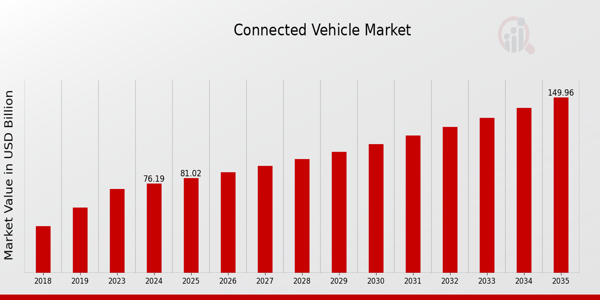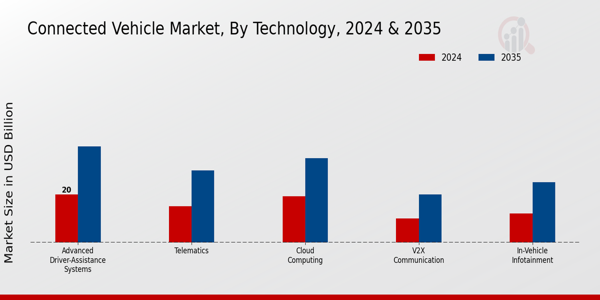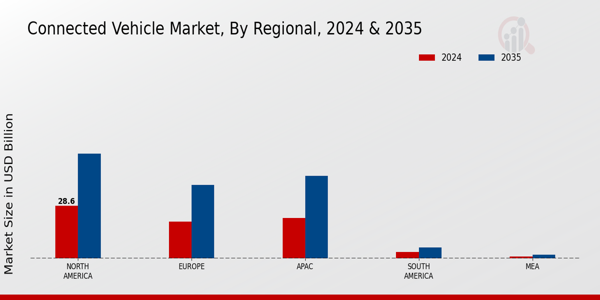Connected Vehicle Market Overview:
As per MRFR analysis, the Connected Vehicle Market Size was estimated at 71.64 (USD Billion) in 2023. The Connected Vehicle Market Industry is expected to grow from 76.19(USD Billion) in 2024 to 150 (USD Billion) by 2035. The Connected Vehicle Market CAGR (growth rate) is expected to be around 6.35% during the forecast period (2025 - 2035).
Key Connected Vehicle Market Trends Highlighted
The Connected Vehicle Market is witnessing significant growth driven by advancements in technology and increasing demand for enhanced safety features in vehicles. One of the key market drivers is the rising emphasis on vehicle safety and the integration of connectivity systems that can improve traffic management, reduce accidents, and provide real-time data to drivers. Additionally, growing consumer expectations for seamless connectivity, particularly with mobile devices, are pushing automotive manufacturers to innovate in-vehicle infotainment systems and connected services. This trend highlights the need for interoperability between vehicles and infrastructure, which is becoming crucial for ensuring efficient and safe transport systems on a global scale.
Opportunities to be explored in this market include the development of smart cities that utilize connected vehicle technology to enhance urban mobility. Governments are increasingly investing in infrastructure that supports vehicle-to-everything (V2X) communication, allowing vehicles to connect with traffic signals, roads, and other vehicles. These investments provide a fertile ground for market participants to expand their offerings and leverage new business models. Furthermore, the advent of electric vehicles (EVs) is also driving the need for connected features, such as charging management and range optimization. Recent trends indicate a growing focus on sustainability and environmental impact.
Consumers and automotive companies alike are prioritizing eco-friendly solutions, which include the integration of connected technologies that promote efficient driving and energy management in vehicles. As the global automotive landscape shifts towards automation and connectivity, the integration of artificial intelligence and machine learning technologies is also becoming relevant, allowing vehicles to learn from their surroundings, enhance user experience, and further improve safety. These evolving trends suggest a dynamic shift in the Connected Vehicle Market, paving the way for future innovations and improved mobility solutions.

Source: Primary Research, Secondary Research, MRFR Database and Analyst Review
Connected Vehicle Market Drivers
Increasing Adoption of Advanced Driver Assistance Systems
The growing use of Advanced Driver Assistance Systems (ADAS) is contributing to a notable uptick in the Connected Vehicle Market. According to data from the Global Automakers Association, during the last three years, the number of cars equipped with technologies like adaptive cruise control and lane-keeping assistance has increased by 35%. The main causes of this change are government legislation requiring safety features in cars and customer desire for increased driving comfort and safety.
The introduction of strict safety regulations by nations like Germany and Japan has further accelerated the development and use of these technologies. Businesses like Continental and Bosch are spearheading this development by making significant investments in R&D to raise the effectiveness and usefulness of these networked systems. The Connected Vehicle Market is expected to develop significantly over the next years as a result of this increased demand.
Growth in the Internet of Things Connectivity
The expansion of the Internet of Things (IoT) is a crucial driver for the Connected Vehicle Market Industry. The number of connected devices in the automotive sector is expected to reach 20 billion globally by 2025, according to forecasts from industry think tanks. This remarkable growth is largely propelled by the increasing number of smartphones and smart devices that integrate with vehicles. Organizations like IEEE and the International Telecommunication Union are actively researching and publishing frameworks for IoT connectivity, which facilitate inter-device communication, enhancing the overall driving experience.
Moreover, automakers such as Ford and General Motors are heavily investing in IoT technologies to enhance vehicle tracking, predictive maintenance, and real-time data analytics, which are indispensable features that cater to the modern consumer's needs.
Government Initiatives Favoring Autonomous Driving
Government initiatives worldwide are significantly propelling the Connected Vehicle Market Industry, particularly toward autonomous driving technologies. Numerous countries, including the United States and the United Kingdom, have set ambitious targets to enhance connected vehicle infrastructure, aiming for fully autonomous vehicles on public roads by the mid-2030s. According to the U.S. Department of Transportation, public investments in connected vehicle programs have accelerated by over 50% in the past four years, which will help in the widespread adoption of autonomous technologies.
This financial commitment not only enhances research and testing environments but also encourages partnerships between automotive manufacturers and technology firms like Tesla and Waymo, contributing to more rapid market evolution and subsequent growth in the connected vehicles segment.
Connected Vehicle Market Segment Insights:
Connected Vehicle Market Technology Insights
The Connected Vehicle Market has seen significant advancements in the Technology segment, projected to reach a value of 76.19 USD Billion in 2024, with continuous growth leading towards an expected valuation of 150.0 USD Billion by 2035. This segment is characterized by its diverse offerings, including Telematics, V2X Communication, In-Vehicle Infotainment, Advanced Driver-Assistance Systems, and Cloud Computing, each contributing uniquely to the overall market growth. Telematics, valued at 15.0 USD Billion in 2024, plays a crucial role by combining telecommunications and vehicular technology, enabling real-time data exchange that enhances fleet management and vehicle safety. This functionality is increasingly vital for logistics firms striving to optimize operations and cut costs.
The V2X Communication sector, valued at 10.0 USD Billion in 2024, significantly impacts vehicle safety and traffic efficiency by facilitating communication between vehicles, infrastructure, and networks. The integration of such communication systems reflects the market's shift towards smarter urban environments and is essential for enabling autonomous driving capabilities, marking it as a dominant technology in the automotive landscape.
In-Vehicle Infotainment contributes towards consumer satisfaction and engagement, with a market value of 12.0 USD Billion in 2024. This segment enhances the driving experience through multimedia and connectivity features, effectively addressing the evolving consumer demand for technology integration within vehicles. As vehicles become a more common extension of digital lifestyles, this segment's significance is set to grow, creating opportunities to leverage user data for personalized services.
Advanced Driver-Assistance Systems, holding a substantial valuation of 20.0 USD Billion in 2024, are critical for enhancing vehicle safety and reducing accidents. These systems populate the market with features like adaptive cruise control and lane-keeping assistance, contributing significantly to the growing emphasis on vehicle safety standards and regulations globally.
Lastly, Cloud Computing, with a valuation of 19.19 USD Billion in 2024, is the backbone that enables the seamless integration of various technologies within connected vehicles. This segment fosters the storage and processing of data, allowing for software updates and feature enhancements over the air, significantly improving vehicle functionality and user experience. The interplay between these technologies forms the crux of the Connected Vehicle Market, with substantial investments aimed at improving connectivity, safety, and overall customer experience in vehicles. As the market continues to evolve, the insights derived from the Connected Vehicle Market segmentation will play a crucial role in driving future innovations and shaping the automotive industry's landscape.

Source: Primary Research, Secondary Research, MRFR Database and Analyst Review
Connected Vehicle Market Vehicle Type Insights
The Connected Vehicle Market is poised for substantial growth, with a valuation of 76.19 billion USD expected in 2024 and projected to reach 150.0 billion USD by 2035. The Vehicle Type segment is crucial, encompassing various categories, including Passenger Vehicles, Commercial Vehicles, Motorcycles, and Buses, each playing a distinct role in the market's dynamics. Passenger Vehicles dominate this segment, largely due to increased consumer demand for advanced safety features and in-vehicle connectivity, while Commercial Vehicles are rapidly evolving with the adoption of IoT technologies for fleet management and operational efficiency.
Motorcycles, though a smaller segment, are gaining traction as manufacturers incorporate connectivity for enhanced rider safety and navigation. Buses also stand out, especially in urban areas where smart public transport solutions are being implemented to improve efficiency and reduce congestion. Trends such as urbanization and the growing emphasis on sustainability are significant growth drivers, presenting numerous opportunities in the market. Furthermore, the Connected Vehicle Market segmentation reflects changing consumer preferences and the need for innovation in vehicle technology, aligning with publicly available statistics highlighting increased investments in connected mobility solutions worldwide.
Connected Vehicle Market Connectivity Type Insights
The Connected Vehicle Market is experiencing notable growth through various Connectivity Types, crucially contributing to its overall valuation, expected to reach 76.19 USD Billion by 2024 and eventually 150.0 USD Billion by 2035. Among these Connectivity Types, Dedicated Short-Range Communication is essential for enabling vehicle-to-vehicle and vehicle-to-infrastructure communications, enhancing road safety and traffic management. Cellular Networks serve as a backbone for real-time data exchange and are increasingly important due to their extensive coverage and compatibility with 5G technology, allowing seamless connectivity.
Satellite Communication provides remote accessibility crucial for vehicles operating in underserved areas or rough terrains, extending the reach of connected services. Wi-Fi, often utilized in fleet management, offers a reliable way for vehicles to connect with local networks, enhancing passenger experiences and enabling software updates. The Connected Vehicle Market data indicates that increased demand for advanced driver-assistance systems, coupled with government regulations promoting connected technology, drives this segmentation. As the market evolves, balancing effective connectivity solutions against challenges like security and infrastructure readiness remains a focal point in harnessing the full potential of these technologies.
Connected Vehicle Market End Use Insights
The Connected Vehicle Market is experiencing significant growth within the End Use segment, which includes applications such as Personal, Fleet Management, Public Transportation, and Ride-Sharing. By 2024, the market is expected to reach a valuation of 76.19 USD Billion, reflecting the rising adoption of connected technologies in vehicles across various user segments. Personal use applications are gaining traction, driven by consumer demand for enhanced safety features and infotainment systems, while Fleet Management solutions are essential to optimize operations and improve efficiency, which is vital for businesses aiming to reduce costs.
Public Transportation systems benefit from connected vehicle technologies that provide real-time data, improving service reliability and user experience. Meanwhile, the Ride-Sharing segment is expanding rapidly, capitalizing on the growing trend of shared mobility services. This segment is becoming increasingly significant due to advances in technology, with connected vehicles facilitating effective communication between riders and service providers. As the Connected Vehicle Market continues to evolve, the interplay between these End Use categories will drive innovations and shape the future of mobility.
Connected Vehicle Market Regional Insights
The Connected Vehicle Market, valued at 76.19 USD Billion in 2024, showcases significant regional segmentation that reveals varied growth dynamics. North America, holding a major portion, is valued at 28.6 USD Billion and is projected to reach 57.0 USD Billion by 2035, driven by advanced technology adoption and a robust automotive sector. Europe follows closely, with a valuation of 20.0 USD Billion in 2024 and an expected increase to 40.0 USD Billion, reflecting the region's commitment to sustainability and smart transportation solutions.
Meanwhile, the APAC region, valued at 22.0 USD Billion in 2024, is anticipated to grow to 45.0 USD Billion, attributed to rapid urbanization and rising disposable incomes, making it a key player in manufacturing connected vehicles. South America and the Middle East and Africa (MEA) represent smaller segments, with valuations of 3.5 USD Billion and 1.09 USD Billion in 2024, respectively. However, despite their lower market values, these regions present opportunities for growth as they begin to embrace connected vehicle technologies. The majority holding in North America and Europe signifies their pivotal role in shaping the global industry landscape while emerging markets like APAC indicate a shift towards a more interconnected transportation ecosystem.

Source: Primary Research, Secondary Research, MRFR Database and Analyst Review
Connected Vehicle Market Key Players and Competitive Insights:
The Connected Vehicle Market is characterized by a dynamic landscape that continuously evolves with advancements in technology and changing consumer preferences. As vehicles become more integrated with internet connectivity and intelligent systems, several key players compete for market share by offering innovative solutions and services. The integration of telematics, location-based services, and advanced driver-assistance systems are pivotal elements driving the market. Companies are constantly innovating to stay ahead, pushing the envelope on the functionalities offered in connected vehicles. This competitive environment requires businesses to focus on developing robust ecosystems that provide seamless connectivity, enhance user experience, and ensure security as consumer expectations grow. Furthermore, partnerships and collaborations are increasingly vital for expanding market reach and integrating complementary technologies.
Amazon's presence in the Connected Vehicle Market underscores its strong capabilities in cloud computing and data analytics. The company leverages its Amazon Web Services division to provide scalable and secure platforms that are crucial for automotive applications. This position allows Amazon to not only support vehicle manufacturers in creating connected experiences but also facilitate the development of applications that enhance consumer engagement. Amazon’s strengths lie in its established technology infrastructure, expansive ecosystem, and ability to integrate artificial intelligence and machine learning into vehicle connectivity solutions. By offering personalized services and providing real-time data, Amazon sets itself apart in the connected vehicle domain.
IBM, renowned for its expertise in technology and software solutions, plays a significant role in the Connected Vehicle Market by offering innovative products that enhance vehicle connectivity and data management. With its suite of cloud solutions and advanced analytics capabilities, IBM provides automakers with tools essential for the development of connected vehicle systems. The company’s strengths are rooted in its emphasis on security and data privacy, enabling users to trust connected technologies. IBM's key initiatives include partnerships and collaborations aimed at accelerating innovation in smart mobility. Their focus on integrating AI, blockchain, and IoT into connected vehicles positions them as a leading solution provider. Additionally, IBM's history of mergers and acquisitions in the tech space allows them to incorporate diverse technologies into their offerings, further enhancing their competitiveness in the global market.
Key Companies in the Connected Vehicle Market Include:
- Amazon
- IBM
- Daimler
- Honda
- Waymo
- Toyota
- Tesla
- Samsung
- Qualcomm
- General Motors
- Ford
- BMW
- Cisco
- Nissan
- Volkswagen
Connected Vehicle Market Industry Developments
The Connected Vehicle Market has seen notable advancements recently, driven by increased investment and innovation in automotive technology. In August 2023, Amazon announced a partnership with Ford to integrate Amazon Alexa into Ford vehicles, enhancing the in-car experience. In the same month, Daimler revealed its plan to further develop its connectivity platforms, aiming to improve vehicle automation. Tesla is also pushing boundaries with its Full Self-Driving software, continuously rolling out updates that leverage extensive data analytics. Furthermore, in September 2023, Qualcomm expanded its collaboration with Honda to bolster its connected car technologies, fostering advancements in vehicle-to-everything communications.
In terms of mergers and acquisitions, in July 2023, Ford completed the acquisition of a leading autonomous vehicle technology start-up, signaling strong growth potential in the market. Samsung has recently committed to increasing its investment in automotive electronics, which is expected to enhance the development of connected vehicle systems. The Connected Vehicle Market continues to grow in valuation, with projections estimating it will reach significant milestones by 2025, primarily fueled by the push for electric vehicles, enhanced safety features, and more integrated smart technology.
Connected Vehicle Market Segmentation Insights
Connected Vehicle Market Technology Outlook
- Telematics
- V2X Communication
- In-Vehicle Infotainment
- Advanced Driver-Assistance Systems
- Cloud Computing
Connected Vehicle Market Vehicle Type Outlook
- Passenger Vehicles
- Commercial Vehicles
- Motorcycles
- Buses
Connected Vehicle Market Connectivity Type Outlook
- Dedicated Short-Range Communication
- Cellular Networks
- Satellite Communication
- Wi-Fi
Connected Vehicle Market End Use Outlook
- Personal
- Fleet Management
- Public Transportation
- Ride-Sharing
Connected Vehicle Market Regional Outlook
- North America
- Europe
- South America
- Asia Pacific
- Middle East and Africa
|
Report Attribute/Metric
|
Details
|
|
Market Size 2023
|
71.64(USD Billion)
|
|
Market Size 2024
|
76.19(USD Billion)
|
|
Market Size 2035
|
150.0(USD Billion)
|
|
Compound Annual Growth Rate (CAGR)
|
6.35% (2025 - 2035)
|
|
Report Coverage
|
Revenue Forecast, Competitive Landscape, Growth Factors, and Trends
|
|
Base Year
|
2024
|
|
Market Forecast Period
|
2025 - 2035
|
|
Historical Data
|
2019 - 2024
|
|
Market Forecast Units
|
USD Billion
|
|
Key Companies Profiled
|
Amazon, IBM, Daimler, Honda, Waymo, Toyota, Tesla, Samsung, Qualcomm, General Motors, Ford, BMW, Cisco, Nissan, Volkswagen
|
|
Segments Covered
|
Technology, Vehicle Type, Connectivity Type, End Use, Regional
|
|
Key Market Opportunities
|
Growth in autonomous vehicles, Rising demand for smart transportation, Increased investment in vehicle-to-everything (V2X) technology, Expansion of 5G networks, Enhanced focus on vehicle cybersecurity
|
|
Key Market Dynamics
|
Emerging 5G technology adoption, Increasing consumer safety concerns, Growing demand for autonomous vehicles, Rising vehicle electrification trends, Enhanced in-vehicle connectivity features
|
|
Countries Covered
|
North America, Europe, APAC, South America, MEA
|
Frequently Asked Questions (FAQ) :
The Connected Vehicle Market is expected to be valued at 76.19 USD Billion by 2024.
By 2035, the Connected Vehicle Market is projected to reach a value of 150.0 USD Billion.
The anticipated CAGR for the Connected Vehicle Market between 2025 and 2035 is 6.35%.
North America is expected to hold the largest market share in the Connected Vehicle Market, valued at 57.0 USD Billion by 2035.
In Europe, the Connected Vehicle Market is expected to be valued at 20.0 USD Billion in 2024 and 40.0 USD Billion by 2035.
The Telematics segment of the Connected Vehicle Market is forecasted to reach 30.0 USD Billion by 2035.
The In-Vehicle Infotainment segment is projected to be valued at 25.0 USD Billion by 2035.
Key players in the Connected Vehicle Market include Amazon, IBM, Daimler, Honda, Waymo, Toyota, Tesla, Samsung, Qualcomm, General Motors, Ford, BMW, Cisco, Nissan, and Volkswagen.
The market value for South America in the Connected Vehicle Market is expected to reach 3.5 USD Billion by 2024.
The Cloud Computing segment is estimated to grow to 35.0 USD Billion in the Connected Vehicle Market by 2035.

















